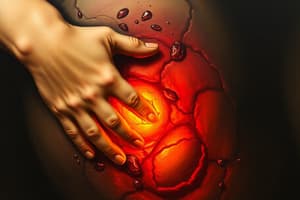Podcast
Questions and Answers
Which of the following is the correct sequence of events in the vascular response phase of the inflammatory response after a cell injury?
Which of the following is the correct sequence of events in the vascular response phase of the inflammatory response after a cell injury?
- Increased capillary permeability, vasodilation, brief vasoconstriction.
- Vasodilation, brief vasoconstriction, increased capillary permeability.
- Brief vasoconstriction, vasodilation, increased capillary permeability. (correct)
- Vasodilation, increased capillary permeability, brief vasoconstriction.
Why is the formation of a clot at the site of inflammation beneficial?
Why is the formation of a clot at the site of inflammation beneficial?
- It immediately generates new epithelial tissue to close the wound.
- It prevents the migration of macrophages to the injury site.
- It traps bacteria, prevents their spread, and provides a framework for healing. (correct)
- It dissolves bacteria and reduces inflammation directly.
A patient's lab results indicate a 'shift to the left' in their WBC differential. What does this usually signify?
A patient's lab results indicate a 'shift to the left' in their WBC differential. What does this usually signify?
- A chronic viral infection.
- An allergic reaction.
- A parasitic infestation.
- An acute bacterial infection. (correct)
How do monocytes contribute to the healing process during the cellular response phase of inflammation?
How do monocytes contribute to the healing process during the cellular response phase of inflammation?
What is the primary role of the complement system in the inflammatory response?
What is the primary role of the complement system in the inflammatory response?
How do corticosteroids work to reduce inflammation?
How do corticosteroids work to reduce inflammation?
Why does administering antipyretics at regular intervals help manage fever?
Why does administering antipyretics at regular intervals help manage fever?
What is the rationale behind using rest as part of the RICE (Rest, Ice, Compression, Elevation) treatment strategy for inflammation?
What is the rationale behind using rest as part of the RICE (Rest, Ice, Compression, Elevation) treatment strategy for inflammation?
Which type of healing intention is characterized by extensive tissue loss, wide irregular margins, and granulation from the edges inward and from the bottom up?
Which type of healing intention is characterized by extensive tissue loss, wide irregular margins, and granulation from the edges inward and from the bottom up?
In wound healing by primary intention, what is the role of the clot that forms in the initial phase?
In wound healing by primary intention, what is the role of the clot that forms in the initial phase?
What is the main characteristic of the maturation phase of wound healing by primary intention?
What is the main characteristic of the maturation phase of wound healing by primary intention?
A patient who is post-operative develops a wound infection. The surgeon decides to leave the wound open to heal, and suture it closed at a later date. Which type of healing intention is this?
A patient who is post-operative develops a wound infection. The surgeon decides to leave the wound open to heal, and suture it closed at a later date. Which type of healing intention is this?
How does negative-pressure wound therapy (NPWT) promote wound healing?
How does negative-pressure wound therapy (NPWT) promote wound healing?
What is the primary mechanism by which hyperbaric oxygen therapy (HBOT) enhances wound healing?
What is the primary mechanism by which hyperbaric oxygen therapy (HBOT) enhances wound healing?
Why is it important to rotate a culture swab over a cleansed area 1-cm² near the center of the wound with enough pressure to extract wound fluid from deep tissue layers and send to the lab within 30 minutes?
Why is it important to rotate a culture swab over a cleansed area 1-cm² near the center of the wound with enough pressure to extract wound fluid from deep tissue layers and send to the lab within 30 minutes?
In an acute care setting, what intervention should be avoided for a patient with blanchable erythema?
In an acute care setting, what intervention should be avoided for a patient with blanchable erythema?
Why is dry, stable necrotic tissue on the feet or heels typically not debrided?
Why is dry, stable necrotic tissue on the feet or heels typically not debrided?
A patient with a Stage 3 pressure injury and a history of immunosuppression shows no classic signs of infection. What is the MOST appropriate action?
A patient with a Stage 3 pressure injury and a history of immunosuppression shows no classic signs of infection. What is the MOST appropriate action?
A patient is being discharged after treatment for a pressure injury. What key education point should be emphasized to the patient and their caregiver to prevent recurrence?
A patient is being discharged after treatment for a pressure injury. What key education point should be emphasized to the patient and their caregiver to prevent recurrence?
What is the recommended daily protein intake for a patient with a pressure injury needing nutritional support?
What is the recommended daily protein intake for a patient with a pressure injury needing nutritional support?
A patient in acute care has a pressure injury with blanchable erythema. Which intervention should be avoided?
A patient in acute care has a pressure injury with blanchable erythema. Which intervention should be avoided?
In acute care for a pressure injury, what principle should guide wound bed management, excluding dry, stable necrotic areas?
In acute care for a pressure injury, what principle should guide wound bed management, excluding dry, stable necrotic areas?
For a patient with a Stage 3 pressure injury, what nutritional support strategy is most appropriate, assuming no specific contraindications?
For a patient with a Stage 3 pressure injury, what nutritional support strategy is most appropriate, assuming no specific contraindications?
A patient is being discharged after treatment for a pressure injury. What key educational point should be emphasized to both the patient and their caregiver to prevent recurrence?
A patient is being discharged after treatment for a pressure injury. What key educational point should be emphasized to both the patient and their caregiver to prevent recurrence?
What is the primary expected outcome when evaluating the care of a patient with a pressure injury?
What is the primary expected outcome when evaluating the care of a patient with a pressure injury?
A patient is admitted with a suspected deep tissue injury on their heel. Which assessment finding would be most indicative of this type of injury?
A patient is admitted with a suspected deep tissue injury on their heel. Which assessment finding would be most indicative of this type of injury?
A patient with a medical device-related pressure injury caused by a splint on their lower leg. What is the most important nursing action to prevent further injury?
A patient with a medical device-related pressure injury caused by a splint on their lower leg. What is the most important nursing action to prevent further injury?
Which of the following assessment findings would suggest that a patient's pressure injury is infected?
Which of the following assessment findings would suggest that a patient's pressure injury is infected?
A patient has developed a Stage 3 pressure injury on their coccyx during a long hospitalization. What is the most appropriate initial action?
A patient has developed a Stage 3 pressure injury on their coccyx during a long hospitalization. What is the most appropriate initial action?
When assessing a dark-skinned patient for pressure injuries, what technique is most important to accurately identify potential tissue damage?
When assessing a dark-skinned patient for pressure injuries, what technique is most important to accurately identify potential tissue damage?
An elderly patient is being admitted to a long-term care facility. Which action is most important for the nurse to perform regarding pressure injury prevention?
An elderly patient is being admitted to a long-term care facility. Which action is most important for the nurse to perform regarding pressure injury prevention?
A patient is at high risk for developing pressure injuries. Which nursing intervention is the most effective in preventing their formation?
A patient is at high risk for developing pressure injuries. Which nursing intervention is the most effective in preventing their formation?
Which of the following complications is most likely to occur if a pressure injury is left untreated?
Which of the following complications is most likely to occur if a pressure injury is left untreated?
A nurse notes that a patient's previously Stage 2 pressure injury is now covered with eschar. How should the nurse classify this pressure injury?
A nurse notes that a patient's previously Stage 2 pressure injury is now covered with eschar. How should the nurse classify this pressure injury?
Which interprofessional team member would be most beneficial to consult for a patient with a large, complex pressure injury to optimize wound healing?
Which interprofessional team member would be most beneficial to consult for a patient with a large, complex pressure injury to optimize wound healing?
A patient is admitted with a suspected deep tissue injury. Which assessment finding is most consistent with this type of injury?
A patient is admitted with a suspected deep tissue injury. Which assessment finding is most consistent with this type of injury?
Which of the following is a key characteristic of a medical device-related pressure injury?
Which of the following is a key characteristic of a medical device-related pressure injury?
Which of the following assessment findings would indicate a localized infection in a pressure injury?
Which of the following assessment findings would indicate a localized infection in a pressure injury?
What is the most common complication associated with pressure injuries?
What is the most common complication associated with pressure injuries?
A Stage 3 pressure injury develops after a patient is admitted to a healthcare facility. According to the guidelines presented, what action should the nurse take?
A Stage 3 pressure injury develops after a patient is admitted to a healthcare facility. According to the guidelines presented, what action should the nurse take?
When assessing a patient with dark skin for pressure injuries, what is the best lighting to use for accurate assessment?
When assessing a patient with dark skin for pressure injuries, what is the best lighting to use for accurate assessment?
What sensation reported by a patient with dark skin may indicate a Stage 1 pressure injury?
What sensation reported by a patient with dark skin may indicate a Stage 1 pressure injury?
What is the primary nursing responsibility in preventing pressure injuries?
What is the primary nursing responsibility in preventing pressure injuries?
Which interprofessional team member would be MOST helpful in addressing a patient's nutritional needs to promote wound healing?
Which interprofessional team member would be MOST helpful in addressing a patient's nutritional needs to promote wound healing?
A nurse is palpating the skin around a suspected pressure injury and notes that the tissue feels soft and yielding, like it contains fluid underneath. How should the nurse document this finding?
A nurse is palpating the skin around a suspected pressure injury and notes that the tissue feels soft and yielding, like it contains fluid underneath. How should the nurse document this finding?
Which of the following is the primary purpose of the inflammatory response?
Which of the following is the primary purpose of the inflammatory response?
During the vascular response phase of inflammation, what physiological change leads to the characteristic signs of redness and heat?
During the vascular response phase of inflammation, what physiological change leads to the characteristic signs of redness and heat?
How does fibrinogen contribute to the inflammatory response?
How does fibrinogen contribute to the inflammatory response?
What is the significance of a 'shift to the left' in the context of a complete blood count during inflammation?
What is the significance of a 'shift to the left' in the context of a complete blood count during inflammation?
How do macrophages contribute to the resolution of the inflammatory response?
How do macrophages contribute to the resolution of the inflammatory response?
Which of the following chemical mediators is responsible for the bronchoconstriction and increased capillary permeability seen in anaphylaxis?
Which of the following chemical mediators is responsible for the bronchoconstriction and increased capillary permeability seen in anaphylaxis?
How do nonsteroidal anti-inflammatory drugs (NSAIDs) reduce inflammation?
How do nonsteroidal anti-inflammatory drugs (NSAIDs) reduce inflammation?
A patient has local manifestations of inflammation. Which of the following would you expect to observe?
A patient has local manifestations of inflammation. Which of the following would you expect to observe?
What is the rationale for using antipyretics to manage a fever?
What is the rationale for using antipyretics to manage a fever?
Why is rest recommended as part of the RICE (Rest, Ice, Compression, Elevation) approach to managing inflammation?
Why is rest recommended as part of the RICE (Rest, Ice, Compression, Elevation) approach to managing inflammation?
What is the key difference between healing by primary intention and secondary intention?
What is the key difference between healing by primary intention and secondary intention?
In wound healing, what is the role of fibroblasts during the granulation phase?
In wound healing, what is the role of fibroblasts during the granulation phase?
Which of the following factors can delay wound healing?
Which of the following factors can delay wound healing?
What is the primary mechanism by which negative-pressure wound therapy (NPWT) promotes wound healing?
What is the primary mechanism by which negative-pressure wound therapy (NPWT) promotes wound healing?
Which of the following is the most important factor in preventing pressure injuries?
Which of the following is the most important factor in preventing pressure injuries?
Flashcards
Pressure Injury: Positioning
Pressure Injury: Positioning
In acute care, avoid positioning patients directly on skin showing blanchable erythema (redness that turns white with pressure).
Wound Debridement
Wound Debridement
Wound debridement involves removing dead or damaged tissue, except in the case of dry, stable necrotic tissue on the feet or heels.
Infection Risk in Pressure Injuries
Infection Risk in Pressure Injuries
Stages 2-4 pressure injuries are usually contaminated or colonized with bacteria. Be aware that symptoms of infection may be subtle or absent, especially in those with chronic wounds or weakened immunity.
Nutritional Support for Healing
Nutritional Support for Healing
Individuals with pressure injuries need a high intake to promote healing. This often means 30-35 calories/kg/day and 1.25-1.50 g of protein/kg/day.
Signup and view all the flashcards
Pressure injury Education
Pressure injury Education
Educate patients and caregivers about the causes, prevention, early signs, and proper care techniques to prevent pressure injuries.
Signup and view all the flashcards
NPUAP Pressure Injury Stages
NPUAP Pressure Injury Stages
Classifies pressure injuries based on tissue damage (stages 1-4, unstageable, suspected deep tissue injury).
Signup and view all the flashcards
Medical Device-Related Pressure Injury
Medical Device-Related Pressure Injury
Pressure injury related to splints, lines that conforms to device shape, common on ears/feet.
Signup and view all the flashcards
Signs of Pressure Injury Infection
Signs of Pressure Injury Infection
An infected wound, showing leukocytosis, fever, odor, drainage, necrotic tissue and pain.
Signup and view all the flashcards
Untreated Pressure Injury Complications
Untreated Pressure Injury Complications
Cellulitis, chronic infection, osteomyelitis, or possible death
Signup and view all the flashcards
Common Pressure Injury Complication
Common Pressure Injury Complication
Recurrence of the pressure injury commonly happens if preventative measures are not taken.
Signup and view all the flashcards
Pressure Injury: When to Assess
Pressure Injury: When to Assess
Assessment and documentation of pressure injuries begins upon patient admission to the facility.
Signup and view all the flashcards
Pressure Injury Healthcare Team
Pressure Injury Healthcare Team
RN, WOC Nurse, Plastic Surgeon, Dietitian, Physical & Occupational Therapist
Signup and view all the flashcards
Serious Reportable Event (SRE)
Serious Reportable Event (SRE)
A stage 3 or 4 pressure injury acquired after admission.
Signup and view all the flashcards
Assessing Dark Skin for Pressure Injuries
Assessing Dark Skin for Pressure Injuries
Purplish/bluish skin, temperature changes, boggy or edematous tissue, itching or pain.
Signup and view all the flashcards
Clinical Problems Related to Pressure Injuries
Clinical Problems Related to Pressure Injuries
Impaired tissue integrity, risk for infection, wound deterioration and recurrence are main clinical problems.
Signup and view all the flashcards
Inflammatory Response
Inflammatory Response
A sequential response to cell injury to neutralize harmful agents, remove debris, and promote healing.
Signup and view all the flashcards
Vascular Response
Vascular Response
Brief vasoconstriction followed by vasodilation due to chemical mediators, leading to increased capillary permeability.
Signup and view all the flashcards
Chemotaxis
Chemotaxis
The directional migration of WBCs (neutrophils, monocytes) to the injury site.
Signup and view all the flashcards
Neutrophils
Neutrophils
First responders; phagocytize bacteria but have a short lifespan; accumulate as pus.
Signup and view all the flashcards
"Shift to the Left"
"Shift to the Left"
Indicates bone marrow is releasing immature neutrophils into circulation, often seen in acute bacterial infections.
Signup and view all the flashcards
Monocytes
Monocytes
Transform into macrophages; rid inflammatory debris to prepare for healing.
Signup and view all the flashcards
Complement System
Complement System
Enzyme cascade mediating inflammation, enhances phagocytosis, increases vascular permeability, promotes chemotaxis, and causes cellular lysis.
Signup and view all the flashcards
Arachidonic Acid
Arachidonic Acid
Stored in cell membranes and converted into prostaglandins, thromboxane, and leukotrienes after injury.
Signup and view all the flashcards
Prostaglandins (PGs)
Prostaglandins (PGs)
Proinflammatory; cause vasodilation, edema, pain sensitization, and fever.
Signup and view all the flashcards
Thromboxane
Thromboxane
Powerful vasoconstrictor and platelet-aggregating agent; promotes clot formation.
Signup and view all the flashcards
Exudate Formation
Exudate Formation
Exudate is made of fluid and leukocytes moving from circulation to injury site.
Signup and view all the flashcards
Systemic Manifestations
Systemic Manifestations
Increased WBC count, malaise, nausea, increased pulse and respiratory rate, and fever.
Signup and view all the flashcards
Regeneration
Regeneration
Replacing lost cells and tissues with the same type.
Signup and view all the flashcards
Repair
Repair
Connective tissue replacing lost cells; occurs via primary, secondary, or tertiary intention.
Signup and view all the flashcards
Primary Intention
Primary Intention
Edges approximated and sutured, blood fills the incision area, acute inflammatory reaction occurs, and capillary growth starts.
Signup and view all the flashcards
Moist Wound Healing
Moist Wound Healing
Keep the wound bed consistently moist to promote healing and prevent disruption of new granulation tissue.
Signup and view all the flashcards
Nutritional support
Nutritional support
Correct nutrient deficiencies with a high-calorie, high-protein diet (30-35 calories/kg/day and 1.25-1.50 g protein/kg/day). Use parenteral (PN) or enteral nutrition (EN) if needed.
Signup and view all the flashcards
Pressure Injury: Patient Education
Pressure Injury: Patient Education
Explain the causes, prevention methods, early signs, and proper wound care to patients and caregivers to prevent future pressure injuries.
Signup and view all the flashcards
Pressure Injury: Expected Outcome
Pressure Injury: Expected Outcome
The ultimate goal is complete healing of existing pressure injuries and maintaining intact skin to prevent any new occurrences.
Signup and view all the flashcards
Device-Related Pressure Injury
Device-Related Pressure Injury
Use of devices designed for diagnostic or therapeutic purposes, injury conforms to the shape of the device.
Signup and view all the flashcards
Complications of Untreated Pressure Injuries
Complications of Untreated Pressure Injuries
Cellulitis, chronic infection, osteomyelitis; can potentially lead to death.
Signup and view all the flashcards
Interprofessional Team for Pressure Injuries
Interprofessional Team for Pressure Injuries
Typically includes: RN, WOC Nurse, plastic surgeon, dietician, physical therapist, and occupational therapist
Signup and view all the flashcards
Assessing Pressure Injury Risk
Assessing Pressure Injury Risk
Use Braden Scale on admission and periodically based on the patient’s condition.
Signup and view all the flashcards
Pressure Injury: Subjective Assessment
Pressure Injury: Subjective Assessment
Gather thorough health history, medication review, and prior treatments.
Signup and view all the flashcards
Pressure Injury: Objective Assessment
Pressure Injury: Objective Assessment
Focused physical exam of skin to check if there are any existing wounds.
Signup and view all the flashcards
Goals for Pressure Injury Care
Goals for Pressure Injury Care
No deterioration, no infection, wound healing and no recurrence.
Signup and view all the flashcards
Nursing Role: Pressure Injury Prevention
Nursing Role: Pressure Injury Prevention
Identifying at-risk patients and implementing prevention strategies.
Signup and view all the flashcards
Inflammation vs. Infection
Inflammation vs. Infection
Not a synonym for infection, but always present with infection. It involves vascular and cellular responses.
Signup and view all the flashcards
Vascular Response Stages
Vascular Response Stages
Brief vasoconstriction then vasodilation, increased permeability, and fluid movement into tissues causing redness, heat, and swelling.
Signup and view all the flashcards
Fibrin's Role
Fibrin's Role
Strengthens clot formation, traps bacteria, and provides a framework for healing.
Signup and view all the flashcards
Arachidonic Acid Products
Arachidonic Acid Products
Following injury, arachidonic acid is converted into Prostaglandins, Thromboxane and Leukotrienes.
Signup and view all the flashcards
Leukotrienes Function
Leukotrienes Function
Bronchoconstriction and increased permeability, causing airway narrowing and edema.
Signup and view all the flashcards
Exudate
Exudate
Fluid and leukocytes that move from the circulation to the injury site.
Signup and view all the flashcards
Local Manifestations
Local Manifestations
Redness, heat, pain, swelling, and loss of function.
Signup and view all the flashcards
Fever Onset
Fever Onset
Release of cytokines, especially PGs, initiate these metabolic changes to raise thermostatic point.
Signup and view all the flashcards
Benefits of Fever
Benefits of Fever
Increased killing of microorganisms, increased phagocytosis, T cell proliferation, and interferon activity.
Signup and view all the flashcards
Chronic Inflammation
Chronic Inflammation
Lasts weeks, months, or years, from persistent or repeated injury, lymphocytes and macrophages are predominant.
Signup and view all the flashcards
Acute Inflammatory Treatment
Acute Inflammatory Treatment
Mediating the inflammatory process, rest, drug therapy, site specific treatment, and prevention of extension/complications.
Signup and view all the flashcards
Anti-inflammatory Drugs
Anti-inflammatory Drugs
Salicylates (Aspirin), NSAIDs, Acetaminophen and Corticosteroids
Signup and view all the flashcards
RICE therapy
RICE therapy
Rest, Ice, Compression, and Elevation: reduces swelling, pain, and stabilizes.
Signup and view all the flashcards
Repair type of Healing
Repair type of Healing
Connective tissue replaces lost cells forming scar. Occurs via primary, secondary, or tertiary intention.
Signup and view all the flashcards
Risk Factors: Pressure Injuries
Risk Factors: Pressure Injuries
Advanced age, anemia, diabetes, elevated body temperature, friction, immobility.
Signup and view all the flashcards



